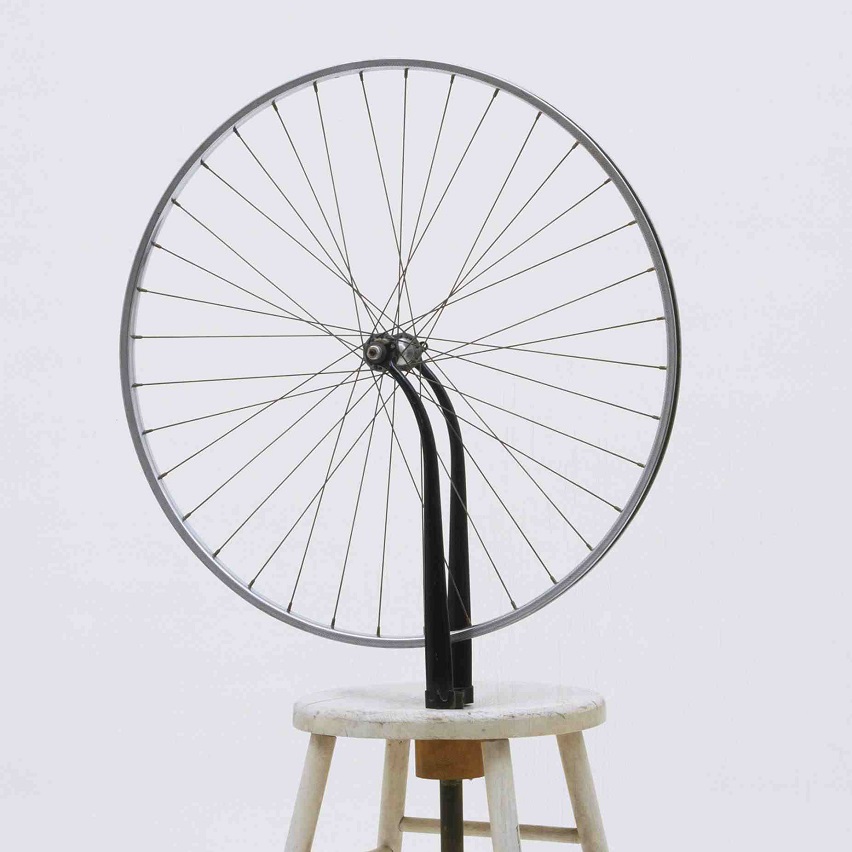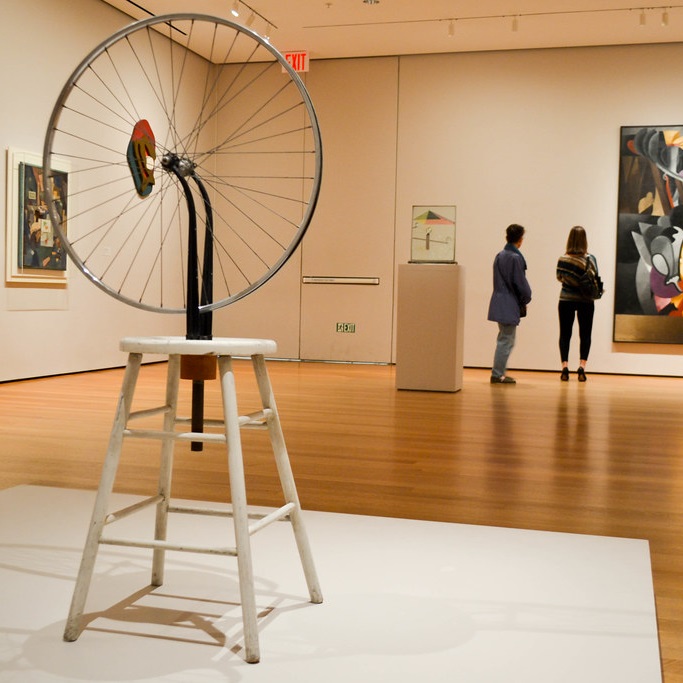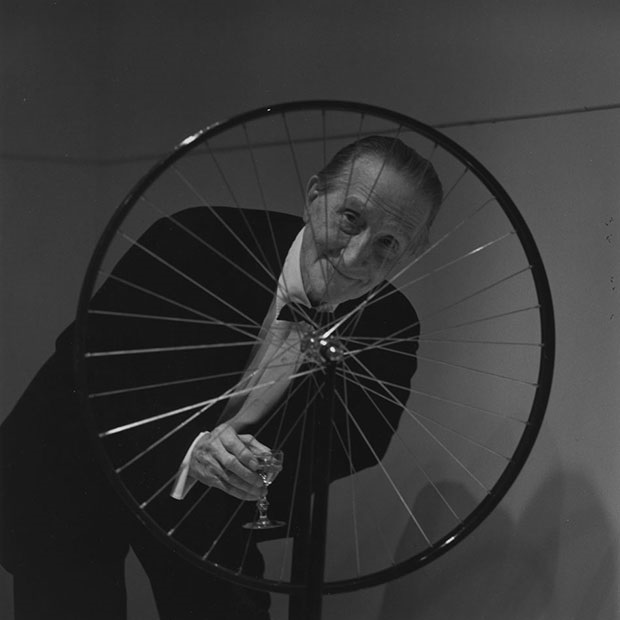Introduction
Defining a New Artistic Language
He chose these objects not for their artistic merit but for their ordinary nature. He wanted to shift the focus from the artist’s skill to the idea behind the artwork. This concept was revolutionary. It questioned the importance of technical skill in making art. It also raised questions about what defines an artwork.

Through ready-mades, Duchamp explored new ways to engage the audience. He invited viewers to think rather than just look. He challenged them to reconsider their definitions of art, value, and creativity. Each ready-made was an ordinary object given new context. The context was the artist’s intention and the environment in which it was displayed.
The public and critics were divided on Duchamp’s ready-mades. Some found them enlightening. Others thought they were a prank. However, Duchamp continued his explorations. The ready-mades became the driving force behind some of his most notable work, including “Bicycle Wheel.”
The Creation of Bicycle Wheel
“Bicycle Wheel” is one of Duchamp’s earliest and most famous ready-mades. Created in 1913, it consists of a wheel mounted on a stool. This combination seems simple. However, it embodies complex ideas about art, value, and interpretation.
Picking the Objects
Duchamp chose the two elements deliberately. He wanted objects that were common and utilitarian. The bicycle wheel and stool both fit this criterion. They had no inherent artistic value. However, by selecting and combining them, Duchamp transformed them.
He took the wheel off its usual context. It was no longer part of a bicycle, used for transportation. He put it atop a stool, a mundane object found in countless homes. The combination changed their context entirely. Viewers were now invited to see them as something else: an artwork.
Challenging Traditional Art
“Bicycle Wheel” challenges traditional notions of what constitutes art. At the time, art was often defined by skill and originality. Artists were expected to create something from nothing. Duchamp subverted this expectation. He argued that art could be anything the artist decided it was.
This shift encouraged viewers to see art in everyday life. It asked them to reconsider the boundaries of creativity. Duchamp’s ready-mades prompted discussions that persist today. Is the artist’s role to create or to choose? Is art about skill or ideas? “Bicycle Wheel” tackled these questions head-on.
Assembly and Display
When Duchamp first assembled “Bicycle Wheel,” he did it for his own amusement. He enjoyed watching the wheel spin. It was an experiment, not initially intended for public display. However, the impact of this work grew over time. It became a key example of Duchamp’s radical approach.
Once “Bicycle Wheel” entered the public eye, it generated significant controversy. Traditionalists argued it wasn’t art. They saw it as a mockery of established norms. However, avant-garde circles celebrated it. They appreciated its challenge to conventional wisdom.
Interpretation and Influence
“Bicycle Wheel” invites endless interpretation. It asks viewers to think, to question, and to engage. Each interpretation reveals something about the viewer’s preconceptions. The work’s simplicity belies its profound impact. It encourages contemplation and discourse.
Since its creation, “Bicycle Wheel” has influenced countless artists. It paved the way for Conceptual Art, Minimalism, and other movements. Duchamp’s ideas challenged and inspired future generations. They continue to provoke thought and discussion.
The Intellectual Framework of Ready-Mades
The ready-mades opened new avenues for artistic expression. They blurred the line between art and everyday objects. Duchamp’s intellectual framework redefined what art could be. He argued that the concept mattered more than the craft.
Art as an Idea
Duchamp was interested in the way ideas could transform objects. He believed that by selecting an object as art, he imbued it with new meaning. This shift was revolutionary. For centuries, art had focused on aesthetics and skill. Duchamp shifted the focus to intention.
The ready-mades represented a new type of art. They were not about visual beauty. They were about the artist’s declaration and the viewer’s perception. Duchamp argued that the act of choosing and presenting an object made it art. This notion democratized art, making it accessible to anyone.
The Role of the Viewer
Duchamp involved the viewer in the artistic process. Traditional art often places the artist as the central figure. Duchamp shifted the focus. He made the viewer an active participant. The ready-mades required interpretation and thought.
By presenting everyday objects as art, he invited viewers to question their assumptions. He prompted them to consider why something is art and what defines artistic value. In doing so, he engaged them in a dialogue about the nature of creativity.
Asking New Questions
The ready-mades forced the art world to ask new questions. They challenged established norms and values. Is the artist’s hand essential in creating art? Can mere selection and declaration create meaning? These questions sparked debates that still resonate today.
Duchamp’s intellectual framework impacted more than just the art world. It influenced philosophy, culture, and thought. By challenging conventional wisdom, Duchamp opened new avenues for exploration. He inspired a broader understanding of creativity and art’s role in society.
Conceptual Art and Duchamp’s Legacy
Duchamp’s ready-mades laid the groundwork for Conceptual Art. This movement emphasized the idea over the object. It sought to engage the mind as much as the senses. Duchamp’s influence on Conceptual Art cannot be overstated.
The Rise of Conceptual Art
In the 1960s and 70s, Conceptual Art gained prominence. Artists like Sol LeWitt, Joseph Kosuth, and Yoko Ono led the way. They built on Duchamp’s idea-centric approach. They created works that emphasized thought, language, and context.
Duchamp’s ready-mades were a direct precursor to this movement. They demonstrated that art could be about ideas rather than aesthetics. Conceptual artists took this concept further. They produced works that questioned reality, perception, and communication.
The Global Reach of Duchamp’s Ideas
Duchamp’s impact was not limited to Western art. His ideas resonated globally. Artists in Asia, South America, and beyond explored similar themes. They challenged local norms and created thought-provoking works.
His influence can be seen in a variety of cultural expressions. From performance art to installations, Duchamp’s legacy endures. His challenge to established norms inspires a wide range of creative endeavors.
Duchamp’s Influence on Contemporary Artists
Contemporary artists continue to draw inspiration from Duchamp. His ready-mades serve as a foundation for new explorations. Artists like Jeff Koons and Damien Hirst embrace Duchamp’s spirit of provocation. They push boundaries and challenge perceptions.
Duchamp’s emphasis on ideas and interpretation resonates in today’s art world. His philosophy encourages innovation and creativity. It allows artists to explore new mediums and concepts.
The Role of Humor in Duchamp’s Work
Humor played a significant role in Duchamp’s art. He often used wit and irony to make his point. His ready-mades, including “Bicycle Wheel,” contain elements of humor. This humor adds depth and complexity to his work.
Satire and Irony
Duchamp used satire and irony to critique the art world. He often poked fun at established norms and conventions. His ready-mades can be seen as a form of satire. They mock the notion that art must be handcrafted and aesthetically pleasing.
“Bicycle Wheel” is a perfect example of Duchamp’s ironic approach. By presenting an ordinary object as art, he challenges the viewer’s expectations. The combination of a wheel and stool seems absurd. However, this absurdity makes a profound statement.
Playing with Expectations
Duchamp enjoyed playing with expectations. He liked to surprise and bewilder his audience. His use of humor defied traditional conventions. It engaged the viewer on a different level.
This playful approach invited viewers to see art in a new light. It encouraged them to look beyond the surface. Duchamp’s humor made his work accessible and thought-provoking.
The Seriousness of Humor
While humorous, Duchamp’s work was also deeply serious. His humor served a purpose. It allowed him to question and critique. It opened doors to new ways of thinking. Duchamp’s use of humor added layers of meaning. It made his work rich and multifaceted.
His ability to balance humor and intellect set him apart. It allowed him to engage a wide audience. Humor became a tool for deeper understanding and exploration. Duchamp’s work reminds us that art can be both playful and profound.
The Continuing Debate on Duchamp’s Ready-Mades
Duchamp’s ready-mades continue to spark debate. They challenge fundamental beliefs about art. Critics and supporters alike have strong opinions. This ongoing discourse highlights the impact of Duchamp’s work.
The Critics
Many critics argue that ready-mades aren’t art. They see them as antiques. This criticism reflects a traditional view. It values the artist’s hand and technical ability. Critics often dismiss ready-mades as gimmicks rather than genuine art. They see them as a rejection of established values.
The Supporters
Supporters of ready-mades see them as revolutionary. They appreciate their challenge to conventional norms. They value the ideas and concepts behind the works. Ready-mades represent a new way of thinking.
Supporters argue that art is more than just physical creation. They believe it’s about ideas, interpretation, and context. Duchamp’s ready-mades embody this philosophy. They see him as a pioneer who expanded the boundaries of art.
The Dual Nature of Ready-Mades
The debate around ready-mades reflects their dual nature.
This duality makes ready-mades intriguing and enduring. They continue to inspire and provoke thought. Duchamp’s work remains relevant, engaging new generations. The debates and discussions they spark are a testament to their impact.
“Bicycle Wheel” in Museums and Exhibitions
“Bicycle Wheel” has appeared in numerous exhibitions. It has been displayed in major museums around the world. Its presence in these spaces underscores its significance.
Display in Museums
Museums give “Bicycle Wheel” a place of honor. It’s displayed alongside masterpieces of traditional art. This juxtaposition highlights its revolutionary nature. It challenges viewers to reconsider their definitions of art.
The work’s presence in museums legitimizes it. It acknowledges Duchamp’s impact and influence. “Bicycle Wheel” has become an icon. It represents a pivotal moment in art history.
Exhibitions and Retrospectives
“Bicycle Wheel” often features in exhibitions and retrospectives. These events explore Duchamp’s life and work. They provide context and background. They offer insights into his creative process and intellectual framework.
Exhibitions highlight the lasting influence of “Bicycle Wheel.” They show how Duchamp’s ideas continue to resonate. They bring new perspectives and interpretations. Each exhibition adds to the work’s rich history.
Global Reach
“Bicycle Wheel” has traveled the world. It has been exhibited in Europe, North America, and beyond. Its global reach represents Duchamp’s universal impact. It reflects the widespread interest in his ideas.
Each exhibition brings the work to a new audience. It invites fresh interpretations. It ensures that Duchamp’s influence continues to grow. “Bicycle Wheel” remains a vital part of the global art conversation.
The Evolution of Public Perception
Public perception of Duchamp’s ready-mades has evolved over time. Initially, many dismissed them. However, they have gained recognition and respect.
Initial Reactions
When Duchamp introduced ready-mades, reactions were mixed. Some saw them as a joke. Others recognized their revolutionary potential. The art world was divided. Critics debated their significance and value.
Many couldn’t understand the concept. They struggled to see ordinary objects as art. Duchamp’s ideas seemed radical and challenging. The initial skepticism reflected traditional views on art.
Growing Recognition
Over time, perceptions began to change. Scholars and critics explored Duchamp’s ideas. They recognized the intellectual depth of his work. Ready-mades gained acceptance and respect.
Duchamp’s influence became more apparent. Artists and thinkers drew inspiration from his work. The art world began to appreciate his contribution. Ready-mades became celebrated examples of avant-garde thinking.
Contemporary View
Today, Duchamp’s ready-mades are iconic. They are recognized as a pivotal moment in art history. They continue to inspire and provoke thought. Public perception has evolved to embrace their significance.
Ready-mades are seen as groundbreaking. They represent a shift in thinking about art. Duchamp’s work is celebrated for its innovation. Public perception has matured to appreciate the intellectual and artistic value.
The Academic Perspective on Ready-Mades
Scholars have extensively studied Duchamp’s ready-mades. They explore their impact, meaning, and significance. Academics provide valuable insights into these works.
Art History and Analysis
Art historians analyze ready-mades in the context of art history. Scholars study the cultural and intellectual context. They consider how ready-mades fit into broader movements. They explore how they challenge and redefine norms. Academic analysis adds depth to our understanding of ready-mades.
Philosophical Implications
Philosophers explore the intellectual implications of ready-mades. They examine the nature of art and creativity. Duchamp’s work raises profound questions. Philosophers delve into these questions and explore their significance.
Cultural Studies
Cultural scholars study the broader impact of ready-mades. They explore how they reflect and influence culture. Duchamp’s work is seen as part of a larger cultural conversation. It engages with issues of value, creativity, and meaning.
Ready-mades are analyzed in various cultural contexts. Scholars explore their global impact and significance. They examine how ready-mades resonate in different cultures. This perspective highlights the universal appeal of Duchamp’s work.
Conclusion: The Enduring Legacy of “Bicycle Wheel”
“Bicycle Wheel” remains a cornerstone of modern art. Its simplicity belies its profound impact. It challenges, provokes, and inspires. Duchamp’s revolutionary ideas continue to resonate.
A Shift in Artistic Thinking
“Bicycle Wheel” represents a fundamental shift in art. Duchamp’s work redefined creativity. It asked new questions and invited new interpretations. It democratized art, making it accessible to everyone. “Bicycle Wheel” embodies this revolutionary spirit.
Influence on Future Generations
Duchamp’s influence endures. His ideas continue to inspire artists, scholars, and thinkers. “Bicycle Wheel” remains a touchstone for innovation. It encourages exploration and creativity.
Future generations will continue to draw inspiration from Duchamp. His work provides a foundation for new explorations. It encourages us to think, question, and engage. “Bicycle Wheel” stands as a testament to his enduring legacy.
A Lasting Impact
“Bicycle Wheel” has left an indelible mark on the art world. It challenges our perceptions and invites endless interpretation. Duchamp’s revolutionary ideas continue to resonate.
The work’s lasting impact is a testament to its significance. Duchamp’s legacy endures through his ready-mades. They remain powerful reminders of the boundless possibilities of art. His vision and creativity will inspire future generations for years to come.




